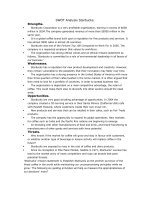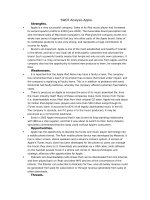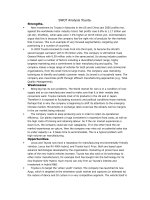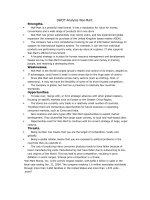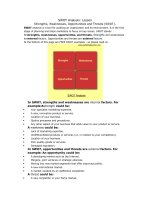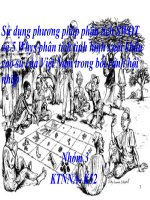SWOT Analysis-lesson
Bạn đang xem bản rút gọn của tài liệu. Xem và tải ngay bản đầy đủ của tài liệu tại đây (56.97 KB, 3 trang )
SWOT Analysis: Lesson
Strengths, Weaknesses, Opportunities and Threats (SWOT).
SWOT analysis is a tool for auditing an organization and its environment. It is the first
stage of planning and helps marketers to focus on key issues. SWOT stands
forstrengths, weaknesses, opportunities, and threats. Strengths and weaknesses
areinternal factors. Opportunities and threats are external factors.
At the bottom of this page are FREE SWOT examples - so please read on.
In SWOT, strengths and weaknesses are internal factors. For
example:Astrength could be:
• Your specialist marketing expertise.
• A new, innovative product or service.
• Location of your business.
• Quality processes and procedures.
• Any other aspect of your business that adds value to your product or service.
A weakness could be:
• Lack of marketing expertise.
• Undifferentiated products or services (i.e. in relation to your competitors).
• Location of your business.
• Poor quality goods or services.
• Damaged reputation.
In SWOT, opportunities and threats are external factors. For
example: An opportunity could be:
• A developing market such as the Internet.
• Mergers, joint ventures or strategic alliances.
• Moving into new market segments that offer improved profits.
• A new international market.
• A market vacated by an ineffective competitor.
A threat could be:
• A new competitor in your home market.
• Price wars with competitors.
• A competitor has a new, innovative product or service.
• Competitors have superior access to channels of distribution.
• Taxation is introduced on your product or service.
A word of caution, SWOT analysis can be very subjective. Do not rely on SWOT too
much. Two people rarely come-up with the same final version of SWOT. TOWS analysis
is extremely similar. It simply looks at the negative factors first in order to turn them
into positive factors. So use SWOT as guide and not a prescription.
Simple rules for successful SWOT analysis.
• Be realistic about the strengths and weaknesses of your organization when
conducting SWOT analysis.
• SWOT analysis should distinguish between where your organization is today, and
where it could be in the future.
• SWOT should always be specific. Avoid grey areas.
• Always apply SWOT in relation to your competition i.e. better than or worse than
your competition.
• Keep your SWOT short and simple. Avoid complexity and over analysis
• SWOT is subjective.
Once key issues have been identified with your SWOT analysis, they feed into marketing
objectives. SWOT can be used in conjunction with other tools for audit and analysis,
such as PEST analysis and Porter's Five-Forces analysis. So SWOT is a very popular tool
with marketing students because it is quick and easy to learn. During the SWOT
exercise, list factors in the relevant boxes. It's that simple. Below are some FREE
examples of SWOT analysis - click to go straight to them
Do you need a more advanced SWOT Analysis?
Some of the problems that you may encounter with SWOT are as a result of one of its
key benefits i.e. its flexibility. Since SWOT analysis can be used in a variety of
scenarios, it has to be flexible. However this can lead to a number of anomalies.
Problems with basic SWOT analysis can be addressed using a more critical POWER
SWOT.
SWOT Analysis Examples
A summary of FREE SWOT analyses case studies are outlined as follows (those in the
table above are far more detailed and FREE!):
Example 1 - Wal-Mart SWOT Analysis. Strengths - Wal-Mart is a powerful retail brand. It
has a reputation for value for money, convenience and a wide range of products all in
one store. Weaknesses - Wal-Mart is the World's largest grocery retailer and control of
its empire, despite its IT advantages, could leave it weak in some areas due to the huge
span of control. Opportunities - To take over, merge with, or form strategic alliances
with other global retailers, focusing on specific markets such as Europe or the Greater
China Region. Threats - Being number one means that you are the target of
competition, locally and globally.
Example 2 - Starbucks SWOT Analysis. Strengths - Starbucks Corporation is a very
profitable organization, earning in excess of $600 million in 2004.Weaknesses -
Starbucks has a reputation for new product development and creativity. Opportunities -
New products and services that can be retailed in their cafes, such as Fair Trade
products. Threats - Starbucks are exposed to rises in the cost of coffee and dairy
products.
Example 3 - Nike SWOT Analysis. Strengths - Nike is a very competitive organization.
Phil Knight (Founder and CEO) is often quoted as saying that 'Business is war without
bullets. 'Weaknesses - The organization does have a diversified range of sports
products. Opportunities - Product development offers Nike many opportunities. Threats
- Nike is exposed to the international nature of trade.
Example 4 - Indian Premier League (IPL) SWOT Analysis. Where will you find the
Mumbai Indians, the Royal Challengers, the Deccan Chargers, the Channai Super Kings,
the Delhi Daredevils, the Kings XI Punjab, the Kolkata Knight Riders and the Rajesthan
Royals? In the Indian Premier League (IPL) - the most exciting sports franchise that
the World has seen in recent years, with seemingly endless marketing opportunities
(and strengths, weaknesses and threats of course!).
Example 5 - Bharti Airtel SWOT Analysis. Weaknesses - An often cited original weakness
is that when the business was started by Sunil Bharti Mittal over 15 years ago, the
business has little knowledge and experience of how a cellular telephone system
actually worked. So the start-up business had to outsource to industry experts in the
field.
